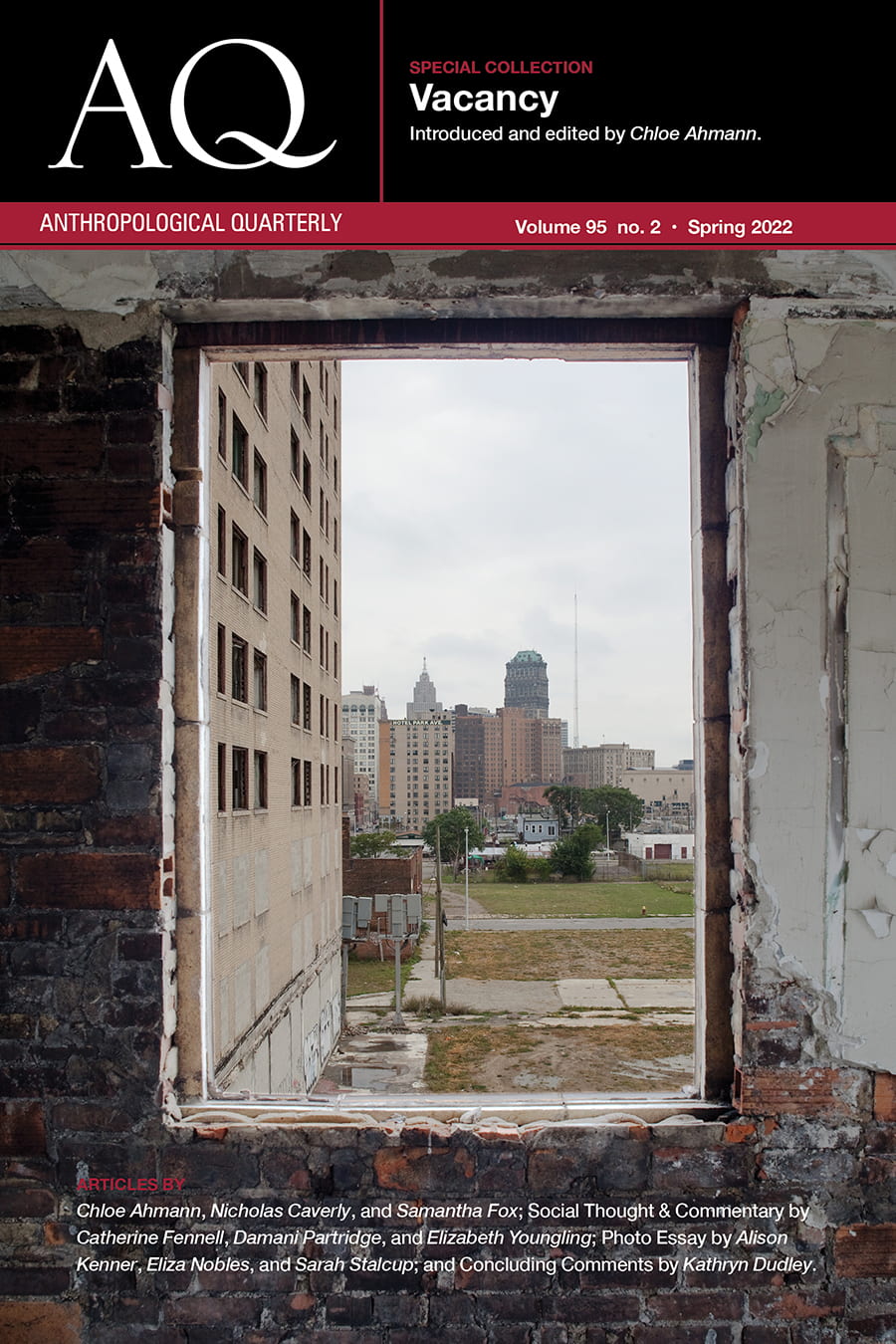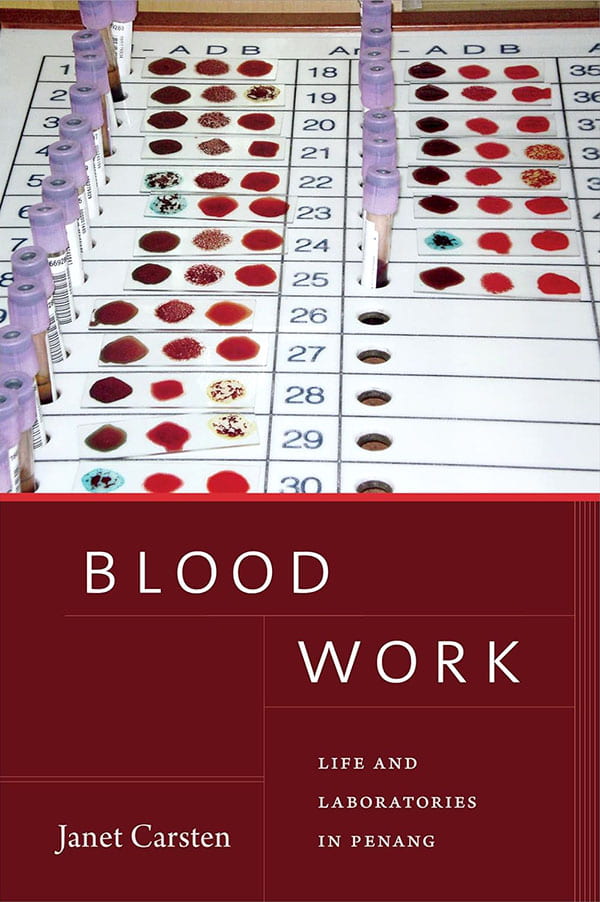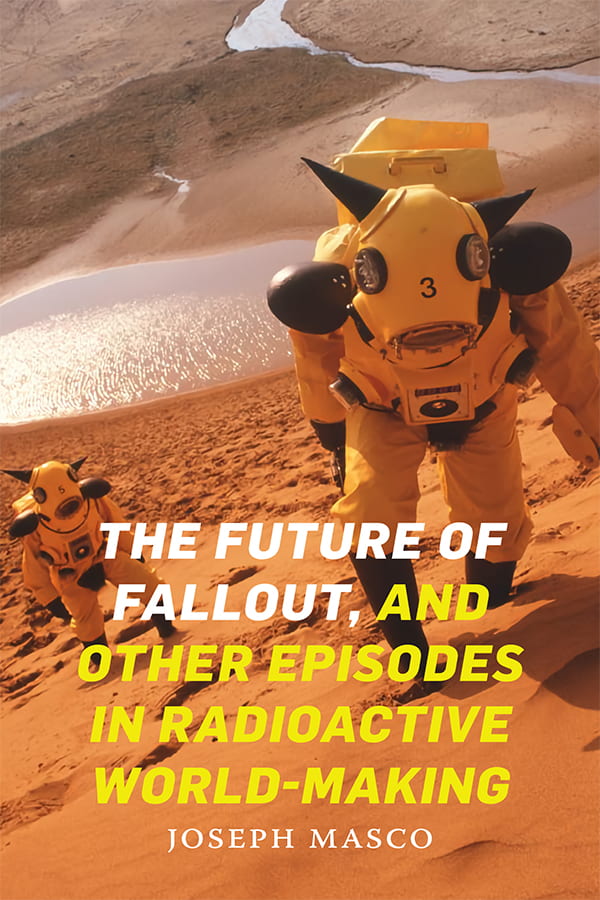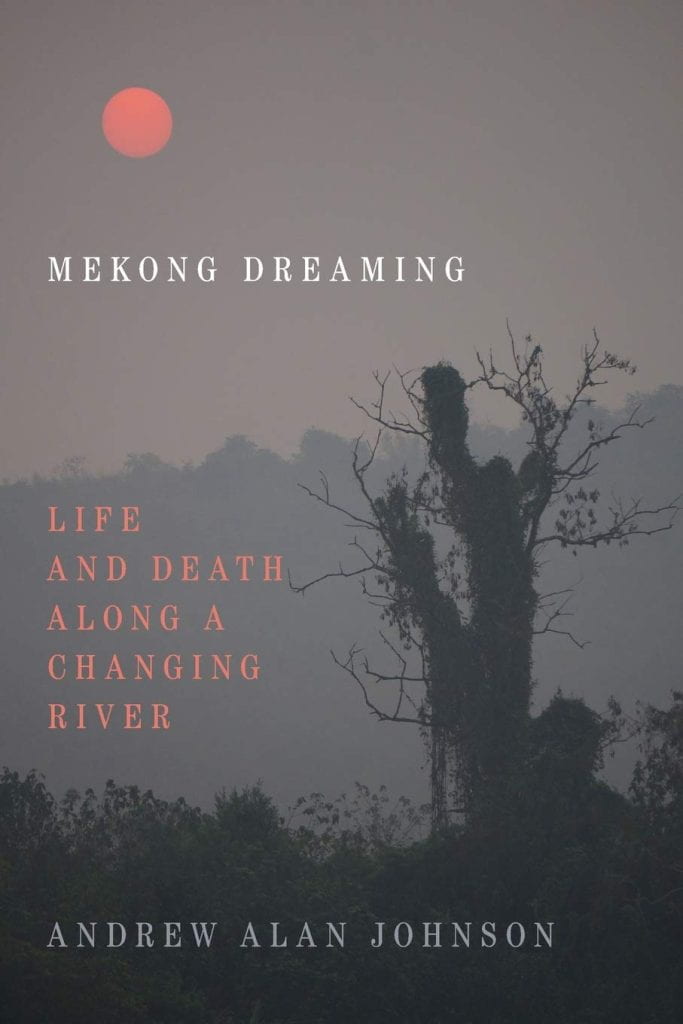
Listed on the National Register of Historic Places, the Hotel Eddystone was built in 1924 by architect Louis Kamper. Once a luxury hotel, it was most recently used as a homeless shelter, and is now empty. © Sean Hemmerle 2009 (Contact Press Images)
TABLE OF CONTENTS
Vol. 95, No. 2
SPECIAL COLLECTION
VACANCY
INTRODUCTION
Chloe Ahmann | Vacancy
ARTICLE
Chloe Ahmann | Postindustrial Futures and the Edge of the Frontier
SOCIAL THOUGHT & COMMENTARY
Elizabeth Youngling | What Else Is There? Vacancy as Development Problem and Solution
ARTICLE
Nicholas L. Caverly | Carceral Structures: Financialized Displacement and Captivity in Detroit
SOCIAL THOUGHT & COMMENTARY
Damani James Partridge | Hostility as Technique: Making White Space in a Black City (Observing a City Over Time through Collective Filmmaking and Collaborative Research)
PHOTO ESSAY
Ali Kenner, Eliza Nobles, and Sarah Stalcup | Cultivating a Politics of Sight for Vacant Land Use in Cities
SOCIAL THOUGHT & COMMENTARY
Catherine Fennell | Rethinking Vacancy, or Thinking with the Going Home
ARTICLE
Samantha Maurer Fox | I Feel Brandenburg: Temporality, Vacancy, and Migration in Germany’s Model Socialist City
CONCLUDING COMMENTARY
Kathryn Marie Dudley | Infinite Parking Lots
BOOK REVIEW ESSAY
Leah Zani | Roberto J. Gonzalez, Hugh Gusterson, and Gustaaf Houtman, eds. Militarization: A Reader and Catherine Besteman’s Militarized Global Apartheid
BOOK REVIEWS





Jenna Grant | Janet Carsten’s Blood Work: Life and Laboratories in Penang
Maxime Polleri | Joseph Masco’s The Future of Fallout, and Other Episodes in Radioactive World-Making
Marisa Solomon | Sophia Stamatopoulou-Robbins’s Waste Siege: The Life of Infrastructure in Palestine
Judith Bovensiepen | Andrew Alan Johnson’s Mekong Dreaming: Life and Death Along a Changing River
Kimberley D. McKinson | Jovan Scott Lewis’s Scammer’s Yard: The Crime of Black Repair in Jamaica

© Sean Hemmerle 2009 (Contact Press Images)
ABSTRACTS
Postindustrial Futures and the Edge of the Frontier
Chloe Ahmann, Cornell University
Port Covington is a 260-acre development underway in South Baltimore City, featuring a multibillion-dollar campus for the popular sportswear brand Under Armour. It promises to transform a “vacant” and degraded former railyard into a “city within a city” and to catalyze Baltimore’s comeback. It also promises to cost a lot. In 2016, after tense public debate, developers secured a $660 million tax increment financing (TIF) deal to begin work, committing taxpayers to decades of debt on the company’s behalf. Eligibility for that deal hinged on making the site’s industrial history visible as an obstacle to profit. The dominant spatial tropes that scholars use to understand dispossession make it hard to appreciate this instrumentalization of the past, as well as developers’ savvy appeals to industrial nostalgia. In this article, I pay particular attention to the blind spots of the frontier concept. Arguments that foreground frontier motifs emphasize erasure as a primary technique of dispossession: by covering up past and present lifeways, “urban pioneers” legitimate land seizure as benign discovery. But in Port Covington’s case, developers dramatized a history of municipal neglect. Far from concealed, this history became a key ingredient in developers’ claims to the land and a mechanism structuring their access to financial options. In the process of exploring these dynamics, I query whether frontier concepts may reach the limits of their usefulness in the postindustrial city. Here, land’s not-so-distant past provides both the template for development dreams and the justification for dispossession by private actors who (the story goes) are best equipped to manage reconstruction. Besides TIF, the range of development incentives available for improving “blighted” spaces—and activists’ studied responses to those incentives—suggest that postindustrial futures are rarely conceived on a blank slate. Instead, historicity drives debates about who the city is for and what it can become. [Keywords: Vacancy, frontier, postindustrial, futures, urban renewal, speculative finance, historicity, United States]
What Else Is There? Vacancy as Development Problem and Solution
Elizabeth Youngling, American Academy of Arts & Sciences
Urban vacant land is often framed as a consequence of political and economic problems that negatively affect land values, tax bases, public safety, and community flourishing. At the same time, vacancy presents governments—and private developers—with opportunities for transformation. This commentary examines a development plan that makes use of vacancy in Chicago, Illinois to shed light on the ways in which vacancy can become a project in itself rather than a side effect of growth, decay, and change. I argue that through processes of erasure, re-inscription, and assemblage, vacancy projects enable redevelopment in ways that further politicians’ and developers’ agendas for post-industrial urban economic growth. In Chicago, vacant industrial land, such as the former Clybourn Corridor Planned Manufacturing District, is simultaneously positioned as an insurmountable problem and an exceptional development opportunity. I use the Clybourn Corridor case to illuminate the social, political, and economic processes through which vacancy is made productive in urban contexts. The relative opacity of such processes has profound implications for urban futures, shaping who makes plans for and benefits from the transformation of urban space. By delving into a vacancy project ethnographically in Chicago, a city struggling, like many, to define a post-industrial future, this commentary contributes to our understandings of vacancy as a tool to draw resources in and make development happen. It demonstrates the political, economic, and social processes through which urban land is defined and reconfigured as a site for public and private intervention as well as opportunity in the contemporary moment. [Keywords: Vacancy, urban development, land, value, economy, post-industrial, United States]
Carceral Structures: Financialized Displacement and Captivity in Detroit
Nicholas L. Caverly, University of Massachusetts Amherst
This article develops an analytic of carceral structures that bridge processes of racist inclusion and exclusion. It does so by examining the relocation of a county jail from Detroit’s central business district into a hazardous waste corridor. In recent years, county administrators have funded jail expansions using revenues from tax foreclosure surpluses produced by evicting majority-Black Detroit residents. Buildings that disappear Black people within the strictures of mass incarceration are financed by the mass displacement of Black people from their homes. Jails have been central features of Detroit’s downtown neighborhood since the 19th century. Surrounding property owners celebrated their late 20th century expansions as a means of supporting districts experiencing the economic fallout of racist population loss. However, when county administrators ran out of funds to complete a jail expansion, developers successfully lobbied to transform the jail site into a campus of a majority-white university. Their plan included rehousing incarcerated people in new jails constructed on the site of unused warehouses adjacent to an incinerator. By attending to Black Detroiters as they navigate dislocations that make incarceration financially possible, this article argues that uneven development is funded by the articulation of racist displacement with racist captivity. In so doing, it offers a model for identifying the expansive structures of carceral institutions as they organize the production of space in the context of racial capitalism. [Keywords: Vacancy, incarceration, racial capitalism, urban space, North America]
Hostility as Technique: Making White Space in a Black City (Observing a City Over Time through Collective Filmmaking and Collaborative Research)
Damani James Partridge, University of Michigan
This commentary examines how White space gets produced in a Black city, highlighting the affective dimensions of this production. In addition to showing how hostility works to produce White space, it establishes a link between this contemporary production and the repetition of the original colonizing project. Finally, this commentary thinks through the ways in which collective filmmaking by long-term residents of the city—in this case, Detroit—offers important alternative affective ways for thinking about and valuing the present and future of the city. In this way, the Black city emerges as a site of possibility, countering persistent images of abandonment and dereliction. [Keywords: Detroit, post-Fordism, Black cities, affect theory, White spaces]
Cultivating a Politics of Sight for Vacant Land Use in Cities
Ali Kenner, Drexel University
Eliza Nobles, University of Pennsylvania
Sarah Stalcup, James Madison University
Perceptions of vacant urban land and resulting policies are based in nature/culture dualisms that condemn abandoned properties as wasteful at best and at worst outright dangerous for communities. Decades of research on urban vacancy reinforce these perceptions, with findings showing higher crime rates, lower property values, and poorer mental health in communities with high rates of vacancy. These established paradigms for thinking about vacant land obscure any benefits that such spaces have while also justifying gentrification. In this essay, we suggest there is more than meets the eye in common assessments of vacant lots. Biodiversity, ecosystem services, and informal community land use are all routinely overlooked in municipal decision-making processes. Using photographs from a pilot field study on ecological health in Philadelphia, Pennsylvania, we advance a politics of sight that reframes overlooked features of abandoned properties. Rather than approaching urban vacancy as a problem to be addressed through development, we argue that vacant land is a problem-space with potential for transformation already contained within it. [Keywords: Care, vacant land, cities, gentrification, greening, photography]
Rethinking Vacancy, or Thinking with the Going Home
Catherine Fennell, Columbia University
Based on ongoing research in Chicago, this commentary focuses on a ubiquitous figure in mainstream imaginaries of late industrial life in the urban American Midwest—the vacant home and the vacant residential lot it becomes when brought down by wrecking, weather, debts, and deferred maintenance. “Vacancy” is the commonplace term most of my interlocutors will reach for to describe such places. More often than not, this description opens onto expectations of imminent refilling. This commentary considers such prevalent descriptions and related expectations alongside other language for these places. I argue that attending to such language complicates these expectations of imminent refilling. What’s more, it challenges urban anthropologists to reconsider how our own expectations of expansive urban growth color and constrain our understandings of late industrial urban futures. [Keywords: Vacancy, growth, homes, late industrial urban life, United States]
Feel Brandenburg: Temporality, Vacancy, and Migration in Germany’s Model Socialist City
Samantha Maurer Fox, Lehigh University
This paper examines the shifting notions of vacancy deployed in Eisenhüttenstadt, Germany from its founding in 1950 as Stalinstadt, an East German socialist utopia, through to the 2015 European Migrant Crisis, when Eisenhüttenstadt found itself with over 1,000 uninhabited apartments and thousands of asylum seekers living in tents, shipping containers, and a high school gym. Eisenhüttenstadt is a steel manufacturing city on the German-Polish border, and its population has declined precipitously in recent decades. As a result, 6,200 apartments were demolished between 2002 and 2015, with more demolitions planned through 2030. But the European Migrant Crisis, which surged in 2015, upended the expectation that spatial and population shrinkage would inevitably come to define Eisenhüttenstadt’s future. In this context, I examine the relationship between vacancy and futurity, noting how vacancy serves as the designation of a spatial locus through which urban futures are imagined and evaluated. I call attention to how vacancy is problematized in moments of crisis, when expected futures are upended, as well as how the legibility of vacancy changes with sociopolitical circumstances. I show how the presentism brought on by the Migrant Crisis stirred up older anxieties about the emptying out of the German countryside that followed the collapse of the East German state. [Keywords: Germany, post-socialism, late industrialism, urban planning, temporality, migration]

